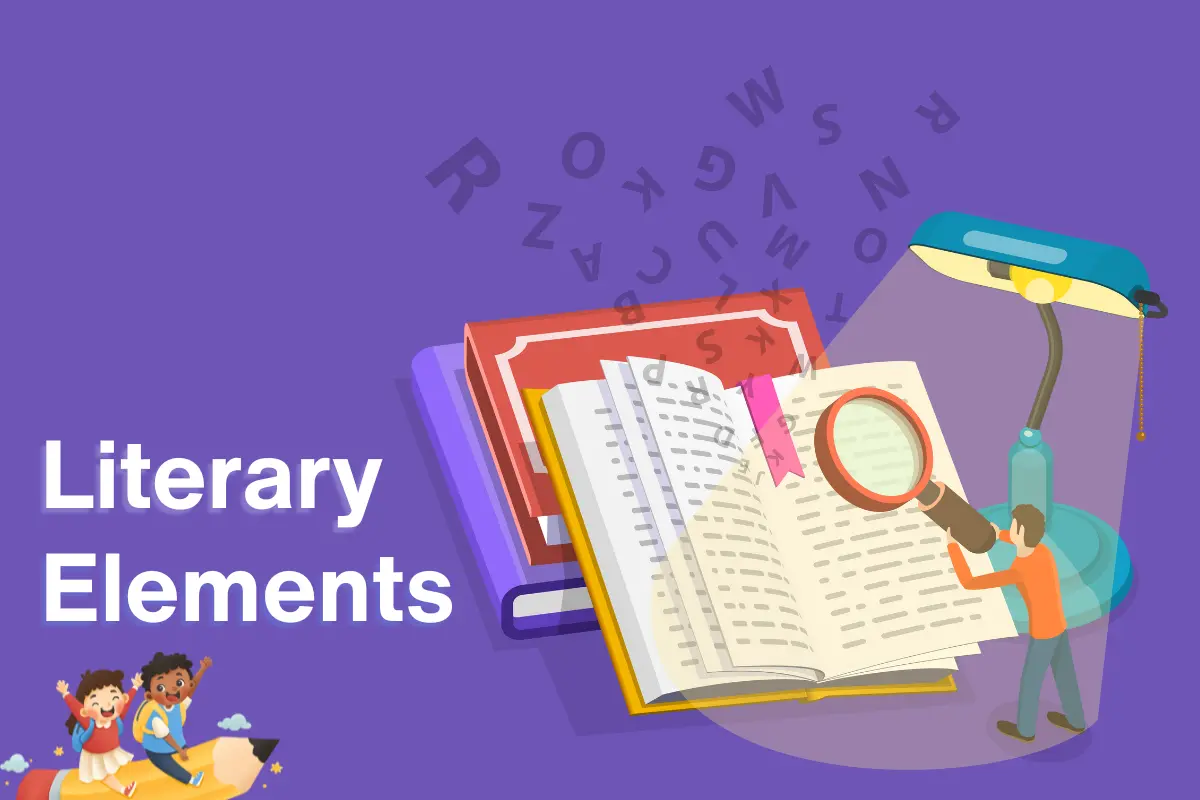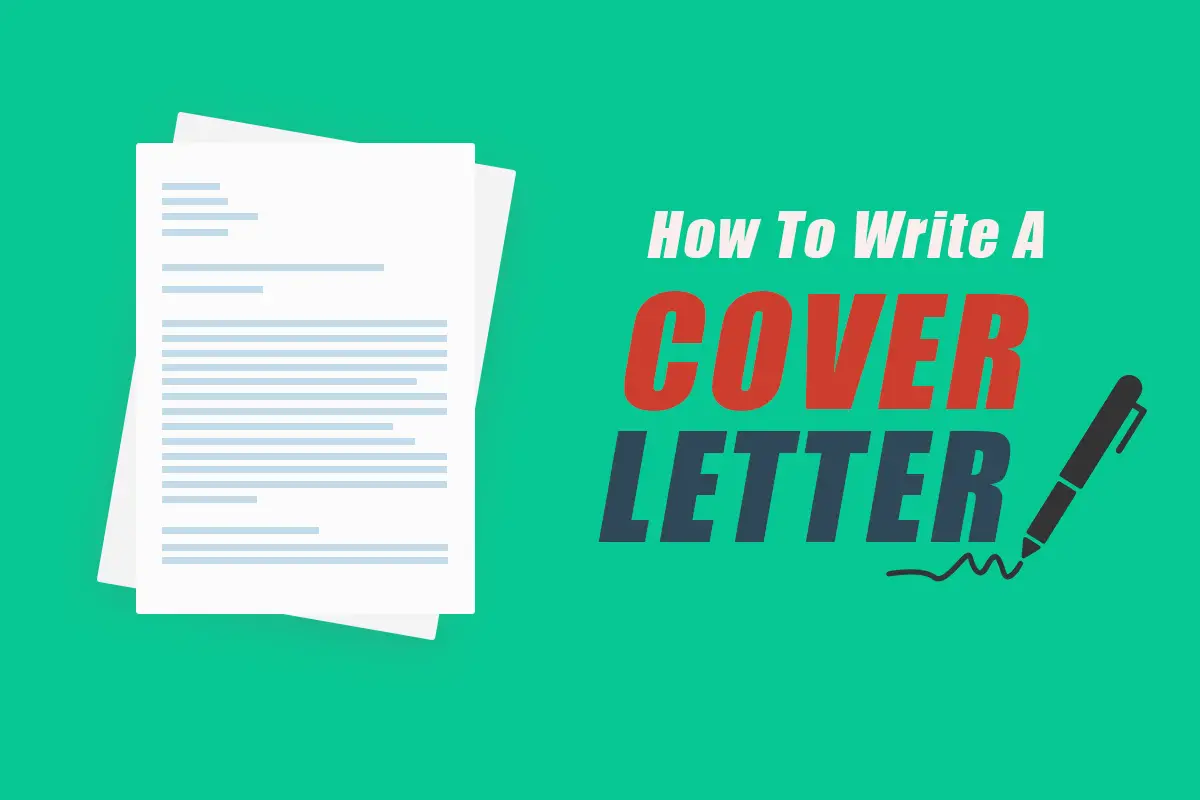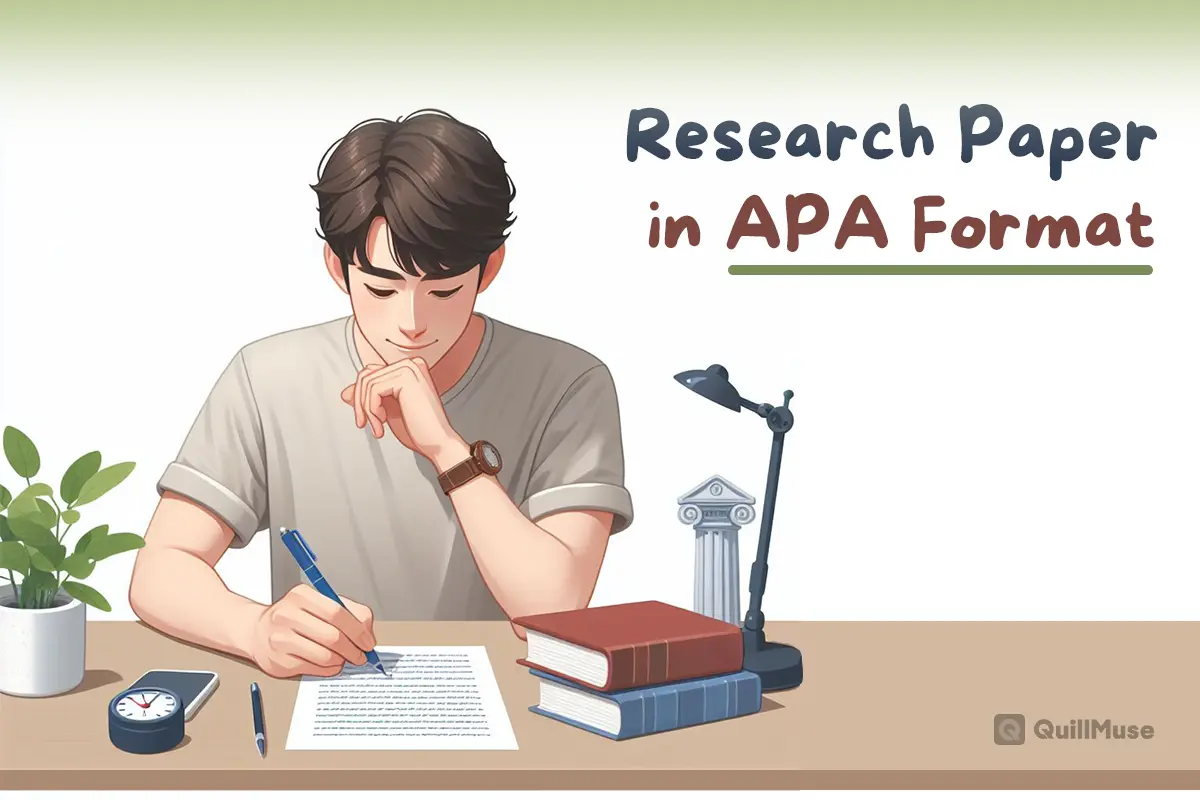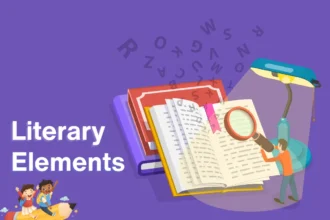Literary Elements Definition, List & Examples
Learn about literary elements, their definitions, lists, examples, and how they differ from literary devices to enhance your understanding of literature.

Zannat Mou
Last updated on Sep 20th, 2024

When you click on affiliate links on QuillMuse.com and make a purchase, you won’t pay a penny more, but we’ll get a small commission—this helps us keep up with publishing valuable content on QuillMuse. Read More.
Table of Contents
Literary elements are the tools of the trade for writers. Literary elements encompass various techniques and devices, including narrative structure, themes, imagery, and more! In other words, literary elements are a large part of what makes a story compelling. Each element serves a distinct purpose, but writers may use multiple elements in any given work to imbue the story with richness and depth.
But no matter the type of literature—be it a novel or short story, pamphlet or poem—you’ll find that authors use literary elements to evoke emotions, create meaning, and help readers grasp important ideas within the text. Understanding these elements and analyzing how and why an author includes them within his or her writing, and how they affect the overall piece, enables readers to appreciate literature on a deeper level.
Literary elements are the things that all literature—whether it’s a news article, a book, or a poem—has to have to be considered “literature.” In this post, we’re going to take a closer look at literary elements. We’ll define each of them, show why they’re important, and then give you some examples of each.
Literary elements definition
Literary elements are the pieces that make up a story. They can be found in any form of literature, from poetry and song lyrics to short stories and novels. They can also be seen and felt in real-life situations. Literary elements[1] add depth to our reading experiences and help us understand why an author writes the way he or she does.
The use of these different types of elements keeps readers engaged by creating vivid mental pictures. Although you may not realize it when reading non-fiction text, this form of writing utilizes many different styles, such as expressive writing (writing with emotion), functional writing (writing for purpose), persuasive writing (trying to influence someone or an opposing view), and newspaper journalistic writing (important news information or boringly written at times). Writers need to remember that they are not just storytellers, but that their responsibility is to the readers. These elements act as building blocks and help in developing a good book or story. Understanding them will also help students when it comes time to write essays or analyze other pieces of literature.
What are literary elements?
Literary elements are the integral building blocks that authors use to create stories. They further help engage readers, develop characters, and convey themes. There are seven common literary elements.
1. Plot
The plot is basically what happens in the story. Plot is the sequence of events in a story or play. The plot is a planned, logical series of events having a beginning, middle, and end. The short story usually has one plot, so it can be read in one sitting.
2. Setting
The setting of a story is the time and place in which it happens. Authors often use descriptions of landscapes, scenery, buildings, seasons, or weather conditions to provide a strong sense of setting. It can also include the social or political context of the time; this can be particularly important for historical fiction, fantasy, or science fiction.
3. Character
The individuals who move the story. They can be protagonists, antagonists, or support characters and are developed by the author through their actions, dialogue, and thoughts.
4. Theme
The theme of a literary work is the main message or ideas conveyed by the work. It’s what forces you to think and deal with emotions and feelings, or issues in society. A theme can be expressed concretely (such as the need for courage in the face of difficulty) or abstractly (such as expressing thoughts on life).
5. Conflict
Conflict is what drives the plot and can be internal or external. This is the struggle between two forces that will either create tension, movement, excitement, or suspense. Conflict can be between characters (man vs. man), between a character and society (man vs. society), between a character and themselves (man vs. self), or between a character and something supernatural (man vs. machine). It could also be simply an external confrontation with nature.
6. Point of View
The point of view (POV) from which a story is told will influence readers’ attitudes toward characters and events. POV options include first-person (the character/narrator uses ‘I’), second-person (‘you’ are the reader), or third-person (an external narrator uses ‘he,” ‘she,’ or ‘they’)—a third person can be limited (one character’s perspective prevails) or omniscient (the narrator knows all characters). The chosen POV helps determine how readers understand and engage emotionally with the story.
7. Symbolism
Symbolism is the use of symbols to signify ideas and qualities by giving them symbolic meanings that are different from their literal sense. Symbolism can take different forms. Generally, it is an object representing another to give an entirely different meaning that is much deeper and more significant. Sometimes, however, an action, an event, or a word spoken by someone may have a symbolic value. For instance, “simile” is a symbol of friendship.
Literary elements vs. literary devices
Literary elements and literary devices are two things that students understand more and more every time they read or write. Though we may use both in conversation, they won’t get you through a real English class because while elements and devices work together to build meaning, they aren’t the same thing. Here’s why:
1. Definition and Nature
Literary Elements
Literary elements are the essential materials that make up a literary work. These are the elements that form a story, such as the setting, characters, theme, plot, and point of view.
Literary Devices
These are the devices of writing that an author uses to communicate meaning in a story, poem, or play. A few examples of literary devices would be things like foreshadowing, simile, metaphor, alliteration, irony, and symbolism.
2. Purpose and Function
Literary Elements
These elements create the basic structural framework or skeleton of the story. They let us know, in simple terms, what we’re about to read or experience – the ‘who’, ‘what’, ‘where’, ’when’, and ‘why’. They are responsible for making sure that the content within a particular category is organized and presented appealingly.
Literary Devices
These are used to improve and provide a better look at the narrative. Also, they help the reader understand the story on different levels.
3. Presence in Text
Literary Elements
These are the basic elements that can be found in essentially every story. For instance, all stories have at their base some combination of a setting, characters, a plotline, and a theme. Stories function to reflect life and to give life meaning—one needs to have lived through times with false friends to understand this reality of friendship.
Literary Devices
Unlike “literary elements”, these are not required for a story. Every author uses an entirely different set (combination) of devices as part of establishing his/her unique voice. You can think of books you’ve read or movies you’ve seen that lack a smattering of the devices below; still, those read/movies were perfectly able to convey their message without being inadequate in any way!
4. Examples
Literary Elements
Like plot structure (exposition, rising action, climax, falling action, resolution), setting (time and place), character (protagonist, antagonist), and theme (central message or idea).
Literary Devices
Metaphor (comparison without using “like” or “as”), simile (comparison using “like” or “as”), hyperbole (exaggeration for effect), foreshadowing (a hint at future events), and irony (a contrast between appearance and reality) are a few examples.
5. Role in Interpretation
Literary Elements
These feature in almost every literary interpretation paper. Becoming familiar with things like plot and character development will help discuss the author’s reasoning and determine the underlying message of the text.
Literary Devices
These assist in bringing out hidden meanings and interpreting important themes. For instance, by identifying the use of a particular form of reasoning such as speciesism; you can better comprehend the purpose.
6. Authorial Control
Literary Elements
An author can dictate how they present these elements, however, the basic elements are necessary for a narrative to even function. For example, in a non-traditional narrative structure, there will still be some form of plot and characters.
Literary Devices
Writers have greater freedom with devices, picking which to use and how to use them to get the effect they want. The use of devices can differ greatly from one piece to another, or even between works of the same writer.
Literary elements are the fundamental building blocks of a literary piece, and literary devices are embellishments used by the writer to create meaning and convey emotion via narration. Both concepts though are not interchangeable, they are related but different in actuality.
Literary elements list and definitions
Here is the list of common literary elements with short definitions:
| Literary Elements | Definitions |
|---|---|
| Plot | It is the logical sequence of events that develops a story. It has a beginning, middle, and end. |
| Character | These are the people who participate in the story. |
| Setting | The time and location in which a story takes place, along with the cultural and historical context. |
| Theme | The primary message or lesson that a work of literature reveals. |
| Point of View | The vantage point from which the writer tells the story, such as first-person or third-person. |
| Tone | The attitude of the author towards the subject or audience is implied in a literary piece through word choice, punctuation, sentence structure, and figure of speech. |
| Mood | The atmosphere that pervades a literary work evokes a certain emotion or feeling from the audience. |
| Conflict | The central struggle between opposing forces drives the plot of a story. |
| Style | The author’s way of writing, which includes his or her typical vocabulary, methods of expression, and techniques of presentation. |
| Symbolism | When something (an object, a person, an action, a place, etc.) is used to represent something else—either by association or by resemblance. It is used to provide meaning to the theme or the moral of the story. |
Literary elements examples
Here are seven examples of literary elements.
1. Example of Plot
In a novel like “Harry Potter and the Philosopher’s Stone” by J.K. Rowling, the plot is meant to take you through Harry Potter’s journey of finding out he is a wizard, his first year at Hogwarts School of Witchcraft and Wizardry, and his fight against Voldemort.
2. Example of Character
Elizabeth Bennet from Jane Austen’s “Pride and Prejudice” is a strong-willed, intelligent woman who values integrity and personal growth, making her one of literature’s most beloved characters.
3. Example of Setting
In Harper Lee’s “To Kill a Mockingbird,” the fictional town of Maycomb, Alabama, as a setting, mirrors some of the racial and social tensions of the American South in the 1930s.
4. Example of Theme
In George Orwell’s “1984,” the theme of totalitarianism is evident in the way the Party controls every aspect of life for the people of Oceania, illustrating how absolute power corrupts absolutely.
5. Example of Point of View
“The Catcher in the Rye” by J.D. Salinger is told from the first-person point of view of Holden Caulfield, allowing for an intimate and subjective look into his mind and life.
6. Example of Tone
The tone of Edgar Allan Poe’s “The Tell-Tale Heart” is dark and ominous, reflecting the narrator’s steadily increasing paranoia and madness.
7. Example of Symbolism
The green light at the end of Daisy’s dock in F. Scott Fitzgerald’s “The Great Gatsby” symbolizes both Gatsby’s dream of rekindling his relationship with Daisy and the American dream of material success.
List of Themes in Literature PDF
Explore the comprehensive list of themes in literature with QuillMuse. Discover 100 universal themes like love, power, identity, and more, each with insightful descriptions. Enhance your understanding and analysis of literary works with this essential guide.
Conclusion
In conclusion, literary elements are the very things that make up a work of literature. They are what we analyze when we read a piece of writing, whether it is our own or someone else’s. Knowing and identifying these components—like plot, character, setting, theme, and point of view—deepens our appreciation for literature. It facilitates our comprehension of stories. Through them, we get to understand the work better. We realize what message or feeling the writer wanted to convey through his/her writing more effectively if there is such an arrangement of thoughts in the text or another type of organization method (writing style). In short, recognizing and examining these known facts makes us understand better.
FAQs
What are literary elements?
Literary elements are the fundamental building blocks of any written work, whether it is a fictional story or a nonfiction essay. These elements include plot, character, setting, theme, point of view, and mood.
Why are literary elements so essential in literature?
Literary elements are fundamental facets of any literary text or piece of writing. They make up the essential ‘parts’ that can be identified within a work of prose, poetry, drama, play, and so on. Understanding them will assist you in deriving better comprehension and interpretation while reading and writing.
How does the setting influence a story?
The setting influences a story by providing the context in which the characters operate. It can create a mood or atmosphere. It can also provide conflict through weather, society, space, time, or any other factor that changes the nature of what is happening between characters.
What is the role of a theme in literature?
A theme is the central idea or ideas explored by a literary work. It’s not the plot, though there are often hints and clues about what the work’s themes may be throughout. The theme isn’t a moral or lesson, because themes can be contradictory and don’t overtly prescribe any kind of behavior.
Quizzes
Which literary elements typically appear in a travelogue? Select three options.
- an argument supported with reasons and evidence
- a person’s account of his or her experiences
- a description of imaginary places and events
- descriptions of sights, cultures, climates, and lands
- drawings, photographs, maps, or memorabilia
Answer: 2. a person’s account of his or her experiences, 4. descriptions of sights, cultures, climates, and lands, & 5. drawings, photographs, maps, or memorabilia.
Which literary elements define narrative poetry? Select 4 options.
- rhythm and rhyme
- paragraphs
- figurative language
- plot and setting
- punctuated sentences
- characters
Answer: 1. rhythm and rhyme, 3. figurative language, 4. plot and setting, & 6. characters.
How we've reviewed this article
Our content is thoroughly researched and fact-checked using reputable sources. While we aim for precision, we encourage independent verification for complete confidence.
We keep our articles up-to-date regularly to ensure accuracy and relevance as new information becomes available.
- Current Version
- Sep 20th, 2024
- Aug 1st, 2024



